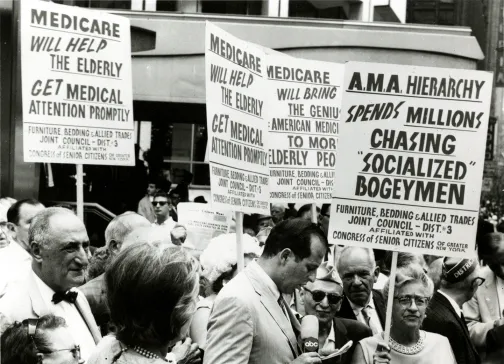
This Date in UCSF History: No to Social Security Medicine
Originally authored by San Francisco orthopaedic surgeon Edward T. Kelley and published in Synapse on December 13, 1961.
Recent remarks by the Secretary of the Department of Health, Education and Welfare and the efforts of twelve delegations of his department who are now touring the country at the citizens’ expense would indicate that a fresh view of the Social Security approach to medical care of those over 65 should be given.
The King-Anderson Bill was introduced at the last session of our Congress and is now being studied by the House Ways and Means Committee. This bill would provide certain medical services to all beneficiaries of the Social Security System and the Railroad Retirement Act who have reached the age of 65.
The cost is financed by increasing the Social Security Tax. In brief, it would provide ninety days of hospitalization subject to a charge of $10 per day for the first nine days of hospital care. It also would provide 180 days of nursing home service, but the combined total of hospitalization and nursing home care could not exceed 150 units.
One unit would equal one day in the hospital. The bill would also provide for home health services of a paramedical nature up to a maximum of 240 visits per year. It would provide for out-patient diagnostic services on a $20 deductible basis.
Doctors’ services are not included under this legislation, with the exception of those doctors who are employed by hospitals such as pathologists, radiologists, anesthesiologists, doctors working in outpatient departments, residents and interns. A bill similar to this, the Forand Bill, was rejected by Congress a year ago in favor of the Kerr-Mills Bill. The Kerr-Mills Bill became law in the United States on October 1, 1960.
By means of this law the Federal Government delivers federal funds to each state on a matching basis. The amount of the federal funds depends upon the per capita income of each state. The lower the per capita income, the greater the federal aid. Each state in turn forms its own legislation depending on the needs of each particular state.
The administration of each state program is, therefore, on a local level. The only part the Federal Government plays in program is in its traditional role of the transference of funds from the Federal Government to each state government.
By this method the Federal Government is excluded from the administration of medical service. California’s version of the Kerr-Mills Bill, which was backed by the California Medical Association, was passed in the Spring of 1961, and will take effect on January 1, 1962.
It provides that anyone in California who is receiving old age assistance or is 65 years old and unable to pay for medical care will receive whatever medical care is required after a thirty-day period of time.
This means that anyone who has had an illness greater than thirty days’ duration will not have their personal savings wiped out by a catastrophic disease. It also means that the plan will not be abused, as have government sponsored plans in other countries such as England and Canada.
The Kerr-Mills Bill is already operational in many states and is being instrumented by a total of 46 states and two territories. It provides for the medical care of those over 65 who are actually in need.
This includes all of those now receiving benefits under the Old Age Assistance Program and anyone else over 65 who demonstrates that he cannot afford medical care. It will be in effect in California at least a year before the King-Anderson Bill could become operational for hospitals, and two years before it could become operational for nursing homes.
The huge majority of the doctors in this country and their elected representatives in the county medical societies, the state medical societies and the A.M.A. support the Kerr-Mills Bill.
They are opposed to the King-Anderson Bill and the Social Security type of approach for financing medical care for the following reasons: The great majority of the aged are not actually in need, as is described by the statistics of the Department of Health, Education and Welfare itself.
These figures show that the median income of a couple receiving Social Security benefits is $183 per month. Their net worth is $9,620. Seventy-five per cent of them own their own homes, with the average value of $8,360. Eighty-seven per cent of these homes are mortgage-free.
Five million of the fifteen million people over 65 in this country are still employed or are wives of those still employed. Eight million have voluntary health insurance. One million receive VA pensions. One and one-half million receive corporate pensions and an additional annuity insurance program.
Most people over 65 are in a better financial situation than those under 65. Their educational worries are over, and their families are raised. They depend mainly on their accumulated assets for support and not their monthly income.
Many of the proponents of the King-Anderson Bill repeat a favored statistic that three-fifth of the people over 65 years of age have an income of less than $1,000 per year.
This means that nine million of the fifteen million over 65 had an income of less than $1,000 per year. There are, however, only two and one-half million people on old age assistance. The error of this statistic is, therefore, adequately shown in that the other seven and a half million people do not qualify as being financially in need. Actually 3/5 of the population under 65 has an income of less than $1,000 per year, but this figure includes children, wives, and other dependents.
Fifteen per cent of those people over 65 may not be able to pay for medical care themselves, but they are already receiving medical care under the provisions of the Old Age Assistance Act and other local measures which will both be supplemented by the Kerr-Mills Bill.
The King-Anderson Bill would provide benefits to all those recipients of Social Security whether they needed care or not. Those most eligible for medical care on a tax-supported basis should be those already receiving old age assistance.
Of the two and one-half million people on O.A.A., however, only 500,000 would receive benefits through the King-Anderson Bill. Through the Kerr-Mills Bill all of these people would be eligible.
Those people on Social Security who did not need medical assistance and those people who did not want collectivized medicine would, in future years, be forced to pay for it under Social Security in addition to their purchase of private medical care.
In our affluent society of today the number of people on the roles of the O.A.A. has decreased from twenty-two per cent of the total in 1950 to fifteen per cent in 1960. It is projected to decrease to eleven per cent in 1970.
This means that the Kerr-Mills Bill would cost less and less as the people who really needed it became fewer. The number of people on Social Security, however, is scheduled to climb rapidly, so that in 1970, twenty million people would be on Social Security.
The results of these two facts are that the King-Anderson Bill would cost more and more where it is not needed, whereas the Kerr-Mills Bill would be slowly faded out of existence as the need decreased.
Senator Kerr of Oklahoma reports that forty per cent of the income of the people of the United States is not taxed under the present Social Security Tax Law.
This is because any income over $55,000 per year is not taxable. The result is that the burden of the King-Anderson Bill would be thrust upon those making less than $55,000 per year. These individuals also do not have the usual benefits of income tax deductions.
A man with a family pays as much Social Security Tax as does a single man. There are many with large families who are already paying more in Social Security Tax than they do in Federal Income Tax. It is obvious, therefore, that the financing of a medical program for the needy over 65 should come from the general tax fund and not through a Social Security Tax.
If the King-Anderson Bill is enacted, it will mean a loss of still another portion of our traditional freedom. As the Bill stands now, Secretary Ribicoff states that all patients will have free choice of their physicians and their hospitals.
The Bill states this in several places, but each statement is always followed by the proviso that all of the foregoing is subject to administrative directive of the Secretary of the Department of Health, Education and Welfare.
Any participating hospital must be approved by Washington, and if the hospital is not approved according to the dictates of the Department, the patient will not have free choice of hospital. If the patient’s physician is on the staff of this nonconforming hospital, then the patient is also denied free choice of physician, if he has to be hospitalized.
Doctors are opposed to the King-Anderson Bill because of the huge inequity in the cost as compared with the Kerr-Mills Bill which is already the law of the land and has not yet been given a fair trial. It has been estimated that the King-Anderson Bill would cost one billion dollars during the first year of operation.
This is contrasted with a figure released by a group of hospital insurance companies which estimates that it would cost $1.3 billion for only two months of hospitalization at the present rate of consumption for the present beneficiaries of the Social Security System.
It can also be compared with the figures from a state-sponsored old age health system in Colorado where the estimated cost for one year’s operation was on the order of $1 million but which rose rapidly to $3 million, then to $7 million, and was most recently quoted as going broke at $10 million per year by the Wall Street Journal.
What government program has ever existed that did not continue to expand? Federal Government employees are already increasing at the rate of 711 each week.
The King-Anderson Bill is to be financed by an increase of one-half per cent in the Social Security Tax on a base of $5,000 per year. This would soon prove to be inadequate, and the tax would have to be raised.
Without the proposed health program, the present Social Security Tax is scheduled to go to nine per cent by 1969. If the health plan is added the tax will go much higher and will not include the health needs of the individual paying the Social Security Tax. It will instead pay for the health care of those who are now retired who never paid into the Social Security System for tax for medical care and neither need it nor want it.
Doctor’s services are not included in the King-Anderson Bill, but doctors and their elected representatives in the American Medical Association oppose it since it would adversely affect the health of a large portion of our population and would be the foot-in-the-door for total socialized medicine which has been over-ruled by our Congress many times in the past.
For our state the Kerr-Mills Bill gives many more benefits than does the King-Anderson Bill. The only difference is that it gives it to people who need it rather than to those who neither need it nor want it.



